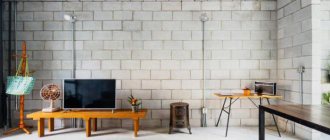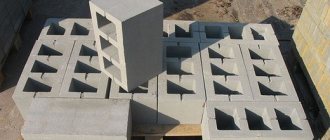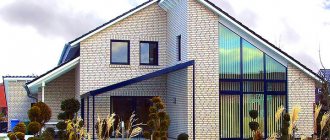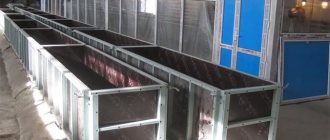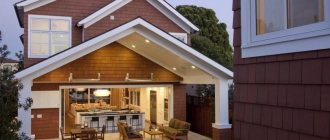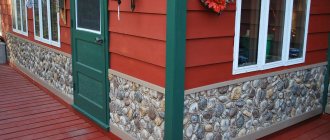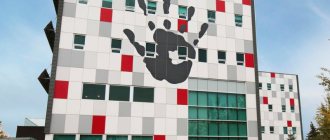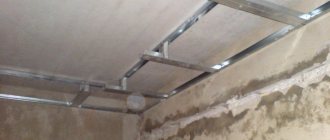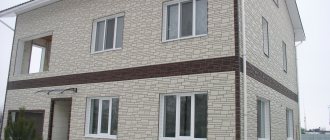Material for walls... What is the best material to build a house from? This question arose for everyone who thought about their home. Build a house with your own hands! What could be nicer! A great dream and a completely achievable task. Let's start by choosing a building material for the walls of our house.
What is the best material to build walls from? What materials are there? What are their strengths and weaknesses? Which ones are better? Durable, environmentally friendly, warm, but made of cheap material. Or made from expensive material? Made of light material, made of cold material, but with insulation, single-layer or multi-layer, classic or modern... What if it’s a two-story house? Then you need floor slabs. Which ones are better? A wide variety of questions may arise. To answer them, let’s plunge into the world of materials for the walls of your dream home.
Building materials for walls
A good house is a strong house. This is how it will be if the building material for its walls is chosen correctly.
The wall is:
- a building structure that encloses or separates some part of the territory;
- side part of the building.
The walls in the house can be divided into several groups depending on the load. Among them are load-bearing, self-supporting, non-load-bearing, hinged and enclosing. All this is shown in the diagram.
The construction of the walls of a house requires the selection of a specific building material. Each of them has individual properties and has its own strengths and weaknesses. Depending on this, it finds application in the construction of walls. The use of various wall materials can be seen in the video.
The following main wall materials are distinguished:
- brick;
- wood;
- ceramic blocks;
- concrete;
- aerated concrete;
- foam concrete;
- cinder blocks;
- vulture panels;
- metal structures.
All these modern materials are widely used in individual construction.
Comparative characteristics of various wall materials
Limestone-shell rock - sawn and recrystallized as a building material
Limestone-shell rock (sometimes called “shell rock”) is a natural, truly environmentally friendly building material, which is a porous carbonate rock made from compressed shells.
Sometimes the concepts of limestone and shell rock are separated, implying different types of building materials. But it's not right. Any shell rock is limestone. There are simply different types of limestone, both in density and in the type and shape of the shells that form its basis. These types of limestone can vary greatly in strength, appearance and other characteristics.
In construction, as a building material, porous sawn limestone-shell rock is most often used, from which blocks and recrystallized limestone are cut - very dense, often layered.
In the massif of sawn limestone - shell rock, shells are easily visible (hence its name). Although at different deposits they can be different in size, shape and color. For example, oolitic limestone-shell rock has inconspicuous shells 1-2 mm in size, almost round, and detrital limestone has shells 1-4 cm in size. Sometimes the voids in one type of shell rock are filled with shells of another - smaller ones.
Blocks are rarely cut from recrystallized limestone, as it is very expensive due to its density. Most often it is used as rubble stone. In quarries it is most often extracted using blasting. Unlike sawn limestone, recrystallized limestone is characterized by very little water absorption and has a crystalline structure, which gives it strength, but it is also “colder”. If you look closely, you can also see shells of different shapes and sizes in it, but they are recrystallized under the influence of temperature and pressure (metamorphism) and almost all the voids of such limestone are filled with a dense carbonate mass.
If you want to build a foundation or basement out of limestone, then dense recrystallized limestone is suitable for this. Porous sawn shell rock is of little use for this.
Depending on the shape and color of the shells, sawn limestone-shell rock from different deposits can differ in color (from white to brown), structure, texture and strength over a fairly wide range.
The strength of sawn limestone-shell rock is characterized by its grade - usually from M15 to M 50, where the number indicates the value of the compressive strength in kg/cm2.
For the construction of buildings, shell limestone is cut out in the form of blocks with dimensions: 490x240x188, 390x190x188 or 390x190x288 mm.
True, due to the fact that blocks of limestone-shell rock are sawn out, and not stamped or molded, their sizes usually have deviations from the standard depending on the mechanisms used for cutting and maintaining standards in a particular quarry, which can be inconvenient when masonry, especially combined (block + brick). This must be taken into account when purchasing shell rock as a building material for the walls of your home and be sure to check their dimensions. If the walls are laid only from shell rock, then the main thing is that the blocks are at least approximately the same size.
Read more about building a house from shell rock.
Advantages of limestone-shell rock as a building material:
- -environmental Safety. It is difficult to find a more environmentally friendly building material than shell rock. Even a tree growing in modern conditions can accumulate harmful compounds from the air or soil in its wood. In addition, in modern construction, wood is impregnated with various compounds to prevent rotting and fire. Limestone-shell rock was formed millions of years ago and was preserved under a layer of alluvial rock, and its radioactivity is usually even below the sensitivity limit of modern instruments;
- - speed of construction, since the blocks are quite large in size;
- -increased thermal insulation compared to solid brick or concrete, which, however, depends on its porosity and density;
- -relatively low cost if you do not take into account the cost of delivery.
Disadvantages of this material:
- block sizes often differ from the standard;
- higher water absorption compared to brick, especially blocks of low grades or highly porous ones;
- thermal conductivity is greater than that of hollow bricks, ceramic blocks, aerated concrete, foam blocks or wood;
- sometimes - heterogeneity of the material (blocks from different batches, or even from the same batch), in terms of strength and porosity.
Brick walls
A building made of brick will be durable.
Brick is a traditional building material, which is an artificial stone. It has its positive and negative qualities: it is heat-intensive, has a high load-bearing capacity, but has a relatively high price.
Types of bricks:
- Adobe - made of clay and straw, instead of which wood shavings, chaff or horse manure are sometimes used. Used in Asian countries. In Russia it is found in rural areas.
- Ceramic - made from baked clay. A high-quality brick should produce a ringing sound and have a uniform reddish color. Through cracks longer than 4 cm are unacceptable; such bricks should be selected for strength and frost resistance. The letter “M” denotes the strength grade. The numbers indicate the permissible compressive load in kg/cm2. The frost resistance class is indicated by the English letter F, the numbers indicate freezing cycles.
- Silicate - made from sand and lime under the influence of steam at a temperature of 170 - 2000 C. For the construction of walls, you can choose bricks of various colors and thicknesses.
- Hyper-pressed is a building material made under high pressure without the use of firing. Fine limestone rocks, scrap from the production of ceramic bricks, various waste from mining and cutting facing stone, small crushed stone, marble and dolomite are added to a small amount of cement with water. The material is as close as possible to natural stone.
Pros and cons of brick construction
| Types of bricks | Advantages | Flaws |
| Adobe | Low cost | Low moisture and frost resistance |
| Good sound insulation and thermal inertia | Walls take a long time to dry and gain strength | |
| Ceramic | Resistance to all climatic conditions | High price |
| Low moisture absorption | Possibility of efflorescence | |
| Silicate | Good sound insulation | High thermal conductivity |
| High strength and frost resistance | High moisture absorption | |
| Hyper-pressed | Resistant to aggressive environments and climatic influences | High price |
| Ideal geometric shape | Requires thorough drying before laying |
Brick
Brick as a material for walls is a classic. Previously, houses were built mainly from brick. The buildings turned out to be durable and aesthetically attractive.
This wall material allows air to pass through well. Therefore, in brick rooms, first of all, there is a favorable microclimate. In addition, excess moisture is removed outside. Moreover, the walls accumulate heat and then release it to the room.
Important characteristic: sound insulation. Thanks to it, brick walls dampen both street and interior noise.
Bricks are made from clay, sand, and lime. These are environmentally friendly materials. They can be of several colors and shades. It depends on the firing. But traditionally brick comes in two colors - red and white. Red consists mainly of clay. White - made of sand and lime. Everyone's preferences are different. For example, someone likes red brick, someone likes white. In the same way, there are also fans of combinations of white and red brick.
Brick classification
Types of bricks by material.
- Raw. This is an unfired clay brick.
- Ceramic. Made from burnt raw material. Usually has a red color. But there may be different shades. The most common type of brick.
- Silicate. Made from quartz sand (approx. 90%) and lime. In other words, white.
- Hyper-pressed. From screenings of calcareous rocks (marble, shell rock, dolomite, up to 90% of the brick composition) and Portland cement (6−8%).
Classification of bricks according to purpose of use.
- Construction or ordinary according to GOST 530-2007 (GOST 530-2012).
- Facial (facing).
- Textured with smooth or uneven edges. For cladding building facades and arranging fences.
- Shaped. For masonry of complex shapes. For example, around windows, window sills, arches.
- Fireproof (furnace, fireclay) according to GOST 390-96. For objects with constant exposure to high temperatures.
- Clinker. For cladding walls, plinths, paving paths.
Depending on the nature of the filling.
- Solid brick. When the pores do not exceed 12-13%.
- Hollow brick. Has cavities obtained during molding. But the strength is like that of a solid brick. However, bending is several times lower.
Red brick
This is a brick fired in special kilns. Firing gives the clay a red color and also improves its strength properties. Red brick is used for both external and internal walls.
Positive qualities of red brick:
- Excellent adhesion of brick and mortar. With competent and correct laying, the adhesion strength is high.
- Fire resistance. Able to withstand high temperatures. Therefore, houses made from it are popular in the south. Moreover, it is used for interior decoration of premises in which it is planned to use heating devices, fireplaces, and stoves.
- Water resistance. Used for the construction of houses and basements. Moreover, it is used for buildings associated with direct interaction with moisture.
- Durability. Houses stand for years and even centuries.
- Strength of buildings. Red brick houses are less susceptible to the elements and emergencies. Therefore, for example, in the event of various earthquakes and fires, brick buildings more often than others remain intact.
Both private houses, cottages, and apartment buildings are built from red brick. In addition, brick is widely used to implement design ideas. This wall material has proven itself over many centuries as a reliable and high-quality construction product.
Disadvantages of red brick.
- Less ability to retain heat than white brick.
- The appearance of white spots, stripes - discharge of salt crystals. But they may not appear immediately, but after several years.
As you know, red brick can come in a variety of shades. Depending on this, as well as on the masonry, each wall looks unique.
Brick sizes
- Single – 250x120x65 mm. Fixed by GOST 530-2007. According to the European marking it has the designation RF.
- Double – 250x120x138 mm.
- One and a half – 250x120x88 mm.
- Modular - 280x130x80 mm.
- Euro brick – 250x85x65 mm.
White brick
When choosing between red and white bricks, it will be wrong to approach the question of which is better or which is worse. Both one and the other wall material are good in their own way.
But you need to take into account the purpose, location of the building, climate, design solutions and personal preferences.
White and red brick are two different building materials. And the scope is different. For example, white brick is successfully used in the northern regions. Because it retains its properties well in frost.
But in the southern regions it does not tolerate high temperatures. This means that houses in these places, on the contrary, are built of red brick.
Composition and properties of white brick
White brick consists of sand and lime with the addition of water. Sand, when exposed to steam, acquires the properties of glass. It seems to become glassy, the grains of sand seem to be soldered to each other.
Unlike red brick, white brick tolerates high temperatures 2 times worse. But it has higher frost resistance. Because white brick has slow moisture absorption. It can withstand 200 or more freeze-thaw cycles. For comparison, red brick has only about 100 such cycles.
White brick is characterized by non-combustibility. Moreover, it has high density. This, firstly, makes it possible to erect tall buildings. And secondly, it allows the brick to be reused. But ordinary sand-lime brick is quite heavy. And this is an additional load on the foundation.
White brick stands out for its consistency of color and size. Of course, it has less choice of colors, but it still exists.
When choosing the size of a brick and its other characteristics, it is first necessary to take into account the scope of application of the material. For example, to decorate the facade it is better to use hollow facing bricks.
But you also need to remember about soil moisture. Because white brick does not like moisture. By the way, in this regard, the brick mortar when laying white bricks must be made thick. Between the masonry and the wall you need space for ventilation, as this will help avoid the accumulation of condensation.
Biobrick
Biobrick is a new material for walls. Appeared quite recently. The author is Assistant Professor of Architecture Ginger Krieg Dosir and a team of specialists. First of all, the peculiarity of the new building material is that it is “grown” biologically.
To produce biobricks, special bacteria, sand, calcium chloride and urea are used. Under the influence of water and chemical processes, sand grains stick together. As a result, within a week the materials turn into durable bricks. The process is very similar to the formation of corals.
Undoubtedly, an important factor for obtaining such a brick is positive temperature. This means no firing is required. Moreover, biobricks can be produced directly on site.
Biobricks have high resistance and durability characteristics. Externally, this brick is similar to sandstone, but denser and more durable. The properties of the new building material are not inferior not only to ordinary brick, but even to natural marble.
So, red, white brick and biobrick. You can choose any type and size. But it is necessary to take into account the specific operating rules and installation features.
Building with bricks is, firstly, not a quick process, and secondly, a serious one. You need to approach it responsibly. When laying bricks yourself, you first need skill, mastery of technology and compliance with certain rules. Of course, you can study and take into account the recommendations for laying bricks. On the other hand, the construction of a house is usually entrusted to professionals. At the same time, they can make an accurate calculation of the amount of material.
Interesting facts about brick!
- 1. In Ancient Russia, brick was called “heel brick” . It got its name because they kneaded clay with their heels. At the same time, bricks were made for a whole year at once. Moreover, this was done only in the summer.
In addition to clay, egg yolk was added to the solution for strength. Then dried in the sun. To test the strength of the brick, it was dropped from a great height.
- 2. "Brick Tax" of Peter I
Peter I introduced a “brick” tax. Everyone entering St. Petersburg had to bring a brick with them. This is how people paid to enter.
It is located next to the pier on the Moika River. According to one version, Brick Lane in St. Petersburg was named so precisely because the “brick tax” was accepted and stored there.
3. World Brick Museum in Japan
The World Brick Museum is located in the Japanese town of Maizuru. Its peculiarity is that each exhibit was part of a world-famous structure.
Walls made of foam blocks
The composition of the foam block includes sand, cement, and foaming agent. It is used for the construction of load-bearing walls and interior partitions. Advantages of foam block as a building material:
- environmentally friendly;
- retains heat well;
- has the ability to “breathe” - release water vapor out;
- excellent fire resistance – resistance to open fire for 8 hours;
- good moisture and frost resistance;
- excellent sound insulation;
- significantly reduces overall construction time;
- low load on the foundation.
A wall made of foam blocks
For all their significant advantages, foam blocks have their disadvantages. They are a low-strength material: the wall can crack if it is overloaded. Water that gets inside at low temperatures will destroy the foam block. This can be avoided if the surface is plastered or treated with a special solution. Not all types of finishing are suitable for cladding walls made of foam blocks.
Popular materials for building walls of a house
There are a lot of them. Let's start with the most proven and reliable option.
Ceramic brick (red)
Made from clay - an environmentally friendly material. Firing gives it a red color and improves its strength properties.
Previously, houses were built mainly from brick. And they performed well. We can say briefly about this material: it is a classic... Time-tested.
Pros of red brick:
- high strength;
- reliability;
- ability to withstand heavy loads for a long time.
Disadvantages of brick:
- high cost of material;
- complex and expensive masonry (requires highly qualified workers);
- relatively large time costs for construction.
Red brick houses are always in price. They are reliable, durable, and warm enough (for wall thicknesses of 60 cm or more). Such a house, after construction, can be sold at a good price after 25 years. Because brick houses last for 100 years.
Ceramic blocks (porous ceramics)
Modern material for the walls of the house. Essentially the same red brick, only with numerous voids. It is made by firing the same clay. However, this creates voids in the material, which significantly improve its thermal insulation properties. In addition, sawdust is added to the starting material during production. When fired, they burn out, resulting in the formation of microscopic pores.
Advantages of porous ceramics:
- excellent thermal insulation properties;
- environmental cleanliness;
- large-format blocks (laying is done quite quickly);
- less weight (and therefore less load on the foundation).
Flaws:
- high price;
- reduced load-bearing capacity and strength (compared to solid ceramic bricks);
- increased fragility (especially noticeable during transportation, loading/unloading);
- easily absorbs moisture.
By the way, one point should be noted regarding the strength characteristics... Manufacturers often claim that porous ceramic blocks (used for the construction of load-bearing walls) correspond in strength to M100 concrete. For example, you can often hear that “the strength is the same as that of ordinary solid red brick.” However... in practice this does not always work out. The strength of porous ceramics may vary from manufacturer to manufacturer. Therefore, you need to be vigilant when purchasing.
Despite its shortcomings, this material is now very popular. Used for the construction of luxury houses.
Aerated concrete
The material is a type of cellular concrete. It is made from quartz sand, cement, and special gas generators. In addition, lime, gypsum, as well as slag and other industrial waste are used. The output is a material with an open porous structure (pore diameter is approximately 1...3 mm).
Advantages of aerated concrete:
- small weight;
- low thermal conductivity;
- ease of machining;
- good strength;
- relatively low price.
Disadvantages of aerated concrete:
- strongly absorbs moisture (due to the open porous structure);
- increased fragility (a reliable foundation is required to prevent even small subsidence).
Now the popularity of aerated concrete is at its height. After all, for a relatively low price you can get a warm and quite durable house. Due to the low thermal conductivity, it is possible to build walls that are much thinner than, for example, in the case of red brick. This further reduces the cost of masonry materials. In addition, the cost of labor for workers is noticeably lower. Houses made of aerated concrete are built relatively easily and quickly.
Foam concrete
Also a type of cellular concrete. Unlike aerated concrete, this material has a closed porous structure. It is made from sand, cement, foaming agent and water.
The technology for making foam concrete is quite simple. Production does not require expensive equipment. And it must be said that this fact not only gives a plus, but also adds an important minus: there is a lot of foam concrete on the market manufactured by dubious private companies (handicraft production). Accordingly, the quality of such material cannot be high.
Advantages of foam concrete:
- light weight;
- good thermal insulation properties;
- ease of processing (easy to drill, saw);
- Due to its closed porous structure (the pores are closed), foam concrete does not absorb moisture as much as aerated concrete.
Disadvantages of foam concrete:
- poor vapor permeability (walls “do not breathe”; a good ventilation system is required);
- almost no bending;
- over time it shrinks significantly (which means cracks may form).
Despite significant disadvantages, foam concrete is used for the construction of residential buildings. This material is also used for sound and heat insulation - walls, roofs, floors, etc.
Wood
Natural material, time-tested. Houses have been built from wood since ancient times. This material has not lost its popularity even today.
Moreover, there are different technologies for constructing wooden houses. So, they can be built from a log house (the old method) - when the trunks are cut to the required length, locks and grooves are made in them, and then they are laid to create walls.
There is also a method of construction from rounded beams. In this case, the logs are processed in production to a smooth surface and marked. In this case, the beams can be planed, sawn, or glued.
Advantages of wood:
- relatively affordable price (compared to other expensive materials);
- environmental cleanliness;
- excellent thermal insulation characteristics;
- aesthetic and attractive appearance;
- no need to build a strong foundation;
- a fairly long service life (with proper construction and care) - naturally, different types of wood have different wear resistance;
- ease of machining.
Disadvantages of wood:
- fire hazard - in the event of a fire, a wooden house can burn completely and very quickly (special treatment is required to protect against fire);
- poor resistance to various parasites, mold, fungi (requires treatment with special substances);
- to one degree or another (depending on the breed) absorbs moisture and is prone to rotting;
- tendency to cracks;
- shrinkage can occur over 3-5 years (the wood dries out and decreases in volume).
Despite the shortcomings, houses built from wood have been and will always be in value. It’s nice to be in a wooden house, you can breathe easily. It is cozy and comfortable. In a word - tree.
Shell rock
This is an absolutely environmentally friendly material of completely natural origin. The rock of this stone is porous, carbonate. It consists of pressed shells. Hence the name - “shell rock” (also called “shell rock”, “limestone”).
Stone can vary in density, shape, type and number of shells that form its base. Accordingly, the strength, aesthetic and other characteristics of different shell rocks can vary greatly.
However, in general, the following can be said about the pros and cons of this stone.
Benefits of shell rock:
- complete environmental friendliness (exceeds even wood, since it requires impregnation with special protective substances);
- does not accumulate radiation (usually it is below the sensitivity level of measuring instruments);
- relatively low price (except for delivery);
- high speed of construction (for example, it can be cut into blocks measuring 490x240x188 mm);
- dense stone has quite high strength (suitable for the construction of load-bearing walls).
Disadvantages of shell rock:
- increased ability to absorb moisture (especially in porous and low-strength stone) - higher than that of ceramic bricks;
- the dimensions of the blocks are inaccurate, significant deviations are often observed (due to the fact that the blocks are not stamped, but cut out);
- the thermal conductivity is inferior to brick, aerated concrete, wood and some other materials;
- heterogeneity in density and strength is often observed (the material is completely of natural origin).
People's attitude towards this stone is ambiguous. In some regions, most houses are built from this stone. In others, they practically do not build due to existing significant shortcomings and give preference to other building materials for the construction of walls. Of course, this is also due to the fact that delivering stone to some regions can be expensive and unprofitable.
Ceramic blocks
Ceramic block or porous ceramic is a material made by firing specially shaped clay blocks. There are 3 main sizes of this raw material:
| № | Dimensions | Volume |
| 1 | 219x250x380 mm | 10.7 NF* |
| 2 | 219x250x440 mm | 12.4 NF |
| 3 | 219x250x510 mm | 14.3 NF |
*NF – normal form, an indicator of the number of bricks of a given block volume.
Ceramic block
The material is environmentally friendly and durable, like any ceramics.
Brickwork.
Brickwork is one of the most common options for building walls.
Based on the type of material, brick is divided into:
ceramic - it is made from clay (specially prepared), sometimes, depending on the quality of the clay (its fat content), a filler is added - sprinkled quartz sand, after molding, the brick is dried at a temperature of 350-400 degrees, after drying, firing is carried out - already at temperature 900-1000 degrees;
silicate - it is made from the following materials: lime, quartz sand and ordinary water. Sometimes a dye is used (if the product requires coloring) and components that help the mixture harden. The main share in the materials (90-92%) is sand. The percentage of lime content is about 8-9%. After molding, the brick is kept for 6.5 - 8.0 hours in an autoclave at a temperature of 165-185 C, while during the first 140-150 minutes the pressure gradually increases to 1.1-1.3 MPa. Over 85-95 minutes, at the final stage, the pressure is gradually reduced to atmospheric pressure.
clinker (clay) is one of the types of ceramic bricks that has a high density and a special structure. It is obtained by using the hyper-pressing method, and the raw material is red refractory clay, which contains various oxides, for example, a high level of aluminum oxide content; the optimal content of aluminum oxide in the raw material is in the range from 17 to 23%. This chemical element reduces the viscosity of the mixture. The content of trivalent oxide in clay should not exceed 8% of the total mass. The calcium oxide content in clay should be no more than 8%. Magnesium oxide in the feedstock should not exceed 4%. After molding by pressing, the bricks are fired at temperatures up to 1100 degrees.
fireclay (kiln) - in fireclay products, the main raw material (up to 70% of the total mass) is fireclay and mineral additives (aluminum oxide). After molding, the raw brick is dried for several days and then fired at different temperatures of 4 stage: 100-200 degrees - moisture evaporation; 400*600 degrees evaporation of chemically bound water; 600-900 degrees - magnesium and calcium carbonates decompose, sulfides and carbon impurities are oxidized; 1350-1400 direct firing;
By type of application:
- private;
- facing (finishing);
- stove;
By size:
- standard (250x120x65mm);
- one-and-a-half (250x120x88mm);
- double (250x120x130mm);
When laying brickwork, a cement-sand mortar of the following grades is used to bind individual bricks together: M50, M75, M100, M150, M200
pros
- One of the most durable materials, service life over 100 years!
- One of the most environmentally friendly materials, since environmentally friendly components are used;
- Massive brick walls have great thermal inertia - they cool down for a long time in winter and heat up for a long time in summer, which allows you to smooth out temperature fluctuations during the day;
- The greater strength of the brickwork allows the use of monolithic or prefabricated reinforced concrete floors;
- High fire resistance allows use in the construction of fireplaces and chimneys;
- High resistance to unwanted insects;
- It perfectly passes air and water vapor through itself, which helps to form a humidity regime indoors;
- The relatively small size of the brick makes it possible to create complex architectural elements on the façade;
Minuses
- The ability to absorb moisture from the outside and be destroyed when this moisture freezes in the winter, which requires additional waterproofing of the walls;
- The large mass of brick walls leads to increased foundation costs;
- An expensive and labor-intensive option for constructing walls;
- The duration of the work is longer than other options;
Aerated concrete blocks in wall construction
Aerated concrete is a lightweight cellular material obtained from a mixture of:
- lime;
- cement;
- fine-grained quartz sand;
- water;
- gas-forming reagents - aluminum powder is most often used.
The curing process is accelerated in autoclave units.
A comparison of gas silicate and foam concrete, building materials for walls, favorably emphasizes the advantage of the first.
Aerated concrete is a relatively inexpensive material, non-flammable, environmentally friendly and durable. Special blocks are made from it.
Modern construction technologies make it possible to use different materials for walls at the same time. Gas silicate blocks can be combined with brick. This will ensure high thermal conductivity of the walls.
Aerated concrete blocks
If a person does not have enough finances for individual construction, then it would be appropriate to independently produce wall material.
Expanded clay concrete blocks
Expanded clay concrete blocks are made from a mixture of expanded clay, sand, cement and water by pressing. Due to the presence of expanded clay in their composition, they have quite good thermal insulation properties, and the presence of cement as a binder provides them with sufficient strength to construct both load-bearing external walls and internal partitions from them.
Such blocks can be made either solid or hollow - with internal voids of various shapes and volumes. Hollow expanded clay concrete blocks can have cylindrical, rectangular, slot-like and fine-slot voids, located both along the block and across it, which can be filled with insulation during laying.
Expanded clay concrete blocks are produced in different sizes and shapes. Most often they are rectangular in shape with dimensions: for masonry of external walls - 300x390x188 and 190x390x188 mm, for internal walls and partitions - 190x390x90 mm.
Laying expanded clay concrete blocks requires reinforcement with reinforcement or mesh every 3-4 rows.
Brick or gas block
Brick is an artificial stone with dimensions of 250x120x65 mm. It is produced by firing clay. Aerated concrete block is an artificially created stone with dimensions of 600x400x250 mm.
Comparison of brick and gas block
| Comparison options | Brick | Gas block |
| Density and mass | 1670 – 1730 kg/m3 | 600 kg/m3 |
| Thermal conductivity | 0.3 – 0.8 W/m Deg. | 0.15 – 0.3 W/m Deg. |
| Frost resistance | 50 cycles | 25 – 35 cycles |
| Strength | 50 – 150 kg/cm2 | 5 – 20 kg/cm2 |
A wall built from aerated block is 3 times lighter than a brick one.
This means that the frame will require less reinforcement. Considering the ability of the building material for the walls of the house to transfer heat, the thickness of the brickwork should be greater. In terms of frost resistance - the ability of a material to maintain strength, brick is superior: it is more durable. Aerated concrete blocks are used in the construction of walls of houses no more than 14 m high. It is not recommended to build load-bearing structures from them. A special feature of aerated concrete blocks is their high geometric accuracy. This allows for less expensive laying using glue. It is faster compared to cement.
Walls should be built in dry, clear weather. It is prohibited to build wet rooms from cellular concrete: saunas, baths, laundries. The walls for them are made only of brick.
Aerated concrete blocks may shrink slightly in size some time after construction, which will lead to the appearance of cracks in the wall. This is not observed in brick.
Gas blocks are easier to machine. Cutting and grinding of aerated concrete can be carried out directly on the construction site using standard hand saws. But the reliability of brick when installing door and window openings is much higher. The fire resistance of brick and gas block is approximately the same.
Cellular concrete blocks are the cheapest material. But the construction of walls requires special technology. The services of workers for such masonry are higher than those of builders working with bricks. However, brick walls are warmer and stronger.
Cellular concrete (lightweight concrete blocks)
Cellular concrete, as building materials for the walls of houses, comes in several types:
- - concrete on porous aggregates;
- - aerated concrete;
- - foam concrete.
Concrete on porous aggregates is easy to distinguish by its structure: it contains balls and spheres that are bound by concrete.
Aerated concrete and foam concrete differ in manufacturing technology. Lime is used as the main binding component for aerated concrete cement is for foam concrete .
Cellular concrete is produced using autoclave and non-autoclave methods. With the autoclave method, hardening of the material occurs at high temperature and under pressure, resulting in a more durable and homogeneous material. In the non-autoclave method, the mixture is left to harden under normal conditions.
Aerated concrete or autoclaved cellular concrete (aerated blocks)
Aerated concrete, as a building material for walls, has a low density (300-500 kg/m3), which makes it possible to produce blocks of increased sizes with a weight of 15-30 kg. A standard block with dimensions of 200x250x600 mm weighs about 18 kg and can replace up to 15-20 bricks in a wall. Thanks to the air contained in the pores, the level of thermal insulation of aerated concrete is almost three times greater than that of brick.
Advantages of aerated concrete as a building material for walls:
- light weight;
- high strength;
- precise geometry;
- low thermal conductivity;
- speed of construction;
- low labor intensity of masonry;
- smooth and even walls;
- easy to cut with a hacksaw;
- incombustible;
- frost-resistant;
- high vapor permeability.
Disadvantages of aerated concrete (aerated blocks):
- low bending strength;
- ability to crack;
- the need to use only special mixtures for masonry;
- during storage it needs protection from precipitation;
- Not moisture resistant enough, if it gets wet it is very difficult to dry.
Foam concrete as a building material for walls
It is similar in appearance to aerated concrete, but differs from it in composition (it does not contain lime), manufacturing technology and scope of application. The shrinkage of foam concrete is much greater than that of aerated concrete. Foam concrete, as a building material for walls, also differs in the quality of its surface - its edges are smooth (aerated concrete has porous edges). During finishing work, plaster does not adhere well to foam concrete, so reinforcing mesh or various primers are used. But, unlike aerated concrete, foam blocks are more moisture resistant, since they contain cement, not lime.
Wooden construction
Several types of wood are used as building materials: pine, spruce, larch, cedar, oak, linden. You should choose according to the properties of the tree and financial resources.
The advantage of wooden walls lies, first of all, in environmental friendliness. Wood is a natural air conditioner. Such a house is warm in winter and cool in summer. The air in the room is renewed up to 30% during the day, so it is easy to breathe in it.
When heated, cracks do not form in the walls, which cannot be said about a brick house. Wooden structures are the most resistant to earthquakes and do not require additional insulation.
Comparison of the thermal conductivity of wood and brick
In terms of thermal conductivity, a log with a diameter of 20 cm replaces brickwork 1 m thick. This significantly reduces the financial costs for the house and reduces the weight of the building, which is economical for the depth and width of the foundation. Its price is sometimes 1/3 of the entire cost of the house. They build wooden walls very quickly at any time of the year.
The main significant disadvantage of wood as a material for building walls is its high fire hazard. Disadvantages also include susceptibility to rotting, damage by fungus and wood-boring beetles. Wood quickly deteriorates under the influence of the atmosphere: sunlight and moisture.
All these shortcomings are easily eliminated with specially developed chemicals. They are applied to the walls and extend the life of the wooden house.
Decorative rock
Decorative brick/stone. Today, few people will be surprised by this method of decorating living rooms and bedrooms, although recently brickwork was not allowed beyond the hallways. It's all about fashion. It turned out that brick as a method of decoration organically combines with many current styles - from classic and rustic to minimalism and loft.
Rigid tiles that imitate brick are based on gypsum, cement, clay and other compounds. So, white gypsum tiles are the most affordable. It is quite light in weight; for its laying you need to purchase special glue.
The main disadvantage of this material is its high moisture absorption - this should be taken into account when planning repairs and should not be used in rooms with high humidity. The average service life is at least 15 years.
In addition to brick, walls can be covered with decorative artificial stone, which imitates sandstone, shell rock, slate, tuff, basalt, etc. Despite the variety of textures, decorative stone is produced mainly from gypsum, sand, clay, cement and corresponding dyes.
The advantages of this finishing option are diversity, which allows the wildest design fantasies to run wild. Artificial stone is quite easy to install, it is hygienic, and lightweight, which can also be considered an advantage.
Decorative stone is most often used to highlight corners, openings, arches, frame a fireplace, in other words, to create stylish accents. Service life if treated with care is up to 30 years.
Decorative stone in the interior: design options, photos
Top ↑
Glued laminated timber
Glued laminated timber is a leading material in wooden construction.
Glued laminated timber is one of the leading materials in wooden construction. It is assembled from individual dried boards of appropriate sizes treated with antiseptic and fireproofing agents. Then gluing occurs with special compounds under high pressure. This is done in order to prevent cracking and torsion of the timber as it dries out.
The beam contains a special tongue-and-groove system, which allows you to assemble walls as quickly as possible. Like many building materials for walls, it is environmentally friendly. Glued laminated timber belongs to the group of combustible materials. With protective treatment, it is relatively durable.
Drywall
Drywall is a worthy alternative to plaster. It is used to create hanging, sub-ceiling systems, for decorating ventilation, pipes, utilities, as well as for covering walls.
Most often, plasterboard is used to decorate rooms with normal humidity - hallways, living rooms, bedrooms. But there is also a special, moisture-resistant drywall, the service life of which can last up to 10 years.
Drywall is a good sound insulator; it absorbs excess moisture and creates a perfectly flat surface. Installation of plasterboard products is not difficult, and they can be cut and used to create various shapes for decoration.
The disadvantage of drywall is that it “eats” the volume of the room, and after installation on the walls it requires puttying of the seams and finishing. It’s also depressing that hanging a TV or shelf on a wall covered with plasterboard is problematic.
Top ↑
Gypsum fiber sheet
Gypsum fiber sheet (GVL) is a modern environmentally friendly homogeneous material with excellent technical characteristics. It is produced by semi-dry pressing of a mixture of gypsum and cellulose waste paper. In terms of its physical properties, gypsum fiber sheet is a fairly strong, hard material, also famous for its fire-resistant qualities.
Gypsum fiber sheet, due to its versatility, has become very widespread in the construction industry. It is used for the installation of interior partitions, floor screeds, suspended ceilings, wall cladding and fire protection of structures. GVL for the floor, which is used to assemble the base of the floor covering, is popular, as well as the facing option, with which, for example, wooden surfaces are sheathed, thereby increasing their fire resistance. Depending on the area of application, gypsum fiber sheets are divided into two types: GVLV (moisture resistant) and GVL (regular).
Gypsum fiber sheet. Floor installation
Advantages of gypsum fiber sheets:
- GVL, compared to gypsum plasterboard, can more easily withstand sawing in any direction, since it is homogeneous in composition;
- Higher strength due to cellulose fiber reinforcement;
- Increased sound insulation.
Disadvantages of gypsum fiber sheets:
- Less bending strength than gypsum board;
- Less suitable for interior decoration than gypsum board;
- The need for pre-treatment before painting.
↑ Less commonly used materials for wall masonry
The following building materials have their own advantages and disadvantages.
↑ Expanded clay concrete
The material is made by pressing from the following components: expanded clay (made from clay), water, cement and sand.
During manufacturing, pores of different shapes and volumes appear in the blocks. Advantages :
- low heat conductivity;
- good strength;
- the cost is relatively low;
- the material is environmentally friendly;
- thanks to the pores, expanded clay concrete has a low weight;
- the production technology is primitive (the material is made independently);
- durable building material;
- good vapor permeability.
Flaws:
- increased absorption of moisture (waterproofing, cladding or covering with film is required);
- you need a solid foundation;
- cold bridges are present due to deviations in the size of the blocks when sealing joints;
- There is a lot of “handicraft” material on the construction market.
Expanded clay concrete is used for laying load-bearing walls, for the construction of partitions, floors, or as insulation.
↑ Arbolit
The material is classified as lightweight concrete. For the production of blocks, cement, organic fillers (up to 85-90%), and chemicals are used. The fillers are wood chips, hemp bonfire, cotton shoots, etc.
Additives are used to eliminate the negative effects of organic matter during cement hardening. Liquid glass, aluminum sulfate and other substances are often used.
Advantages:
- environmental friendliness;
- practically does not conduct heat;
- high fire resistance (the material does not burn, but only chars);
- large blocks allow you to build walls quickly;
- rapid restoration of shape after the influence of loads;
- no reinforced foundation required;
- Screws and nails are easily driven into walls.
Flaws:
- protection from moisture is required;
- not sold everywhere;
- the cost is often inflated.
Developers consider wood concrete to be a good building material for building walls.
↑ Cinder block
The material is made by vibration pressing or natural shrinkage of a solution of slag and concrete. As a filler, in addition to slag, granot sifting, broken bricks, glass cullet, etc. are added.
Cinder blocks are formed solid and with voids.
Advantages:
- does not ignite or burn;
- temperature changes do not affect the quality of the material;
- service life is about 100 years;
- affordable price;
- excellent sound insulation;
- high strength;
- wall laying is done quickly.
Minuses:
- high moisture absorption;
- walls need to be insulated;
- environmental friendliness is in doubt, it all depends on how conscientious the manufacturer is;
- the strength of the cinder block makes it difficult to lay cables and pipes in it;
- The appearance of the walls is unpresentable (needs finishing).
Generally speaking, the material for building walls is not bad. It is often used for foundations and partitions.
The construction market offers material options for building walls. Which one to choose - everyone makes the final decision on their own.
An experienced builder answers: how much does it cost to build a house in a country house today?
